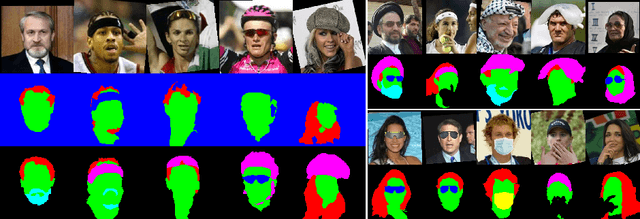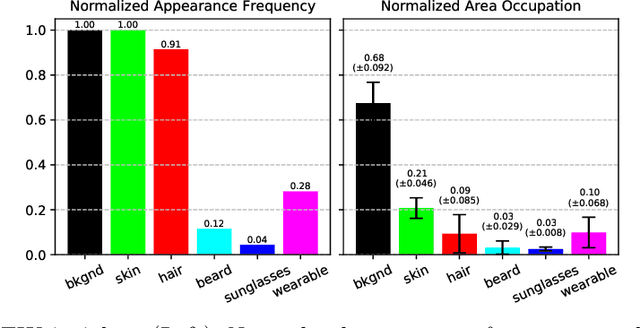Jaume Gibert
LinkMedia
Location Sensitive Image Retrieval and Tagging
Jul 07, 2020



Abstract:People from different parts of the globe describe objects and concepts in distinct manners. Visual appearance can thus vary across different geographic locations, which makes location a relevant contextual information when analysing visual data. In this work, we address the task of image retrieval related to a given tag conditioned on a certain location on Earth. We present LocSens, a model that learns to rank triplets of images, tags and coordinates by plausibility, and two training strategies to balance the location influence in the final ranking. LocSens learns to fuse textual and location information of multimodal queries to retrieve related images at different levels of location granularity, and successfully utilizes location information to improve image tagging.
Extended Labeled Faces in-the-Wild : Augmenting Classes for Face Segmentation
Jun 24, 2020



Abstract:Existing face datasets often lack sufficient representation of occluding objects, which can hinder recognition, but also supply meaningful information to understand the visual context. In this work, we introduce Extended Labeled Faces in-the-Wild (ELFW), a dataset supplementing with additional face-related categories -- and also additional faces -- the originally released semantic labels in the vastly used Labeled Faces in-the-Wild (LFW) dataset. Additionally, two object-based data augmentation techniques are deployed to synthetically enrich under-represented categories which, in benchmarking experiments, reveal that not only segmenting the augmented categories improves, but also the remaining ones benefit.
Exploring Hate Speech Detection in Multimodal Publications
Oct 09, 2019



Abstract:In this work we target the problem of hate speech detection in multimodal publications formed by a text and an image. We gather and annotate a large scale dataset from Twitter, MMHS150K, and propose different models that jointly analyze textual and visual information for hate speech detection, comparing them with unimodal detection. We provide quantitative and qualitative results and analyze the challenges of the proposed task. We find that, even though images are useful for the hate speech detection task, current multimodal models cannot outperform models analyzing only text. We discuss why and open the field and the dataset for further research.
Selective Style Transfer for Text
Jun 04, 2019



Abstract:This paper explores the possibilities of image style transfer applied to text maintaining the original transcriptions. Results on different text domains (scene text, machine printed text and handwritten text) and cross modal results demonstrate that this is feasible, and open different research lines. Furthermore, two architectures for selective style transfer, which means transferring style to only desired image pixels, are proposed. Finally, scene text selective style transfer is evaluated as a data augmentation technique to expand scene text detection datasets, resulting in a boost of text detectors performance. Our implementation of the described models is publicly available.
AI in the media and creative industries
May 10, 2019Abstract:Thanks to the Big Data revolution and increasing computing capacities, Artificial Intelligence (AI) has made an impressive revival over the past few years and is now omnipresent in both research and industry. The creative sectors have always been early adopters of AI technologies and this continues to be the case. As a matter of fact, recent technological developments keep pushing the boundaries of intelligent systems in creative applications: the critically acclaimed movie "Sunspring", released in 2016, was entirely written by AI technology, and the first-ever Music Album, called "Hello World", produced using AI has been released this year. Simultaneously, the exploratory nature of the creative process is raising important technical challenges for AI such as the ability for AI-powered techniques to be accurate under limited data resources, as opposed to the conventional "Big Data" approach, or the ability to process, analyse and match data from multiple modalities (text, sound, images, etc.) at the same time. The purpose of this white paper is to understand future technological advances in AI and their growing impact on creative industries. This paper addresses the following questions: Where does AI operate in creative Industries? What is its operative role? How will AI transform creative industries in the next ten years? This white paper aims to provide a realistic perspective of the scope of AI actions in creative industries, proposes a vision of how this technology could contribute to research and development works in such context, and identifies research and development challenges.
Self-Supervised Learning from Web Data for Multimodal Retrieval
Jan 07, 2019



Abstract:Self-Supervised learning from multimodal image and text data allows deep neural networks to learn powerful features with no need of human annotated data. Web and Social Media platforms provide a virtually unlimited amount of this multimodal data. In this work we propose to exploit this free available data to learn a multimodal image and text embedding, aiming to leverage the semantic knowledge learnt in the text domain and transfer it to a visual model for semantic image retrieval. We demonstrate that the proposed pipeline can learn from images with associated textwithout supervision and analyze the semantic structure of the learnt joint image and text embedding space. We perform a thorough analysis and performance comparison of five different state of the art text embeddings in three different benchmarks. We show that the embeddings learnt with Web and Social Media data have competitive performances over supervised methods in the text based image retrieval task, and we clearly outperform state of the art in the MIRFlickr dataset when training in the target data. Further, we demonstrate how semantic multimodal image retrieval can be performed using the learnt embeddings, going beyond classical instance-level retrieval problems. Finally, we present a new dataset, InstaCities1M, composed by Instagram images and their associated texts that can be used for fair comparison of image-text embeddings.
Learning from #Barcelona Instagram data what Locals and Tourists post about its Neighbourhoods
Aug 20, 2018



Abstract:Massive tourism is becoming a big problem for some cities, such as Barcelona, due to its concentration in some neighborhoods. In this work we gather Instagram data related to Barcelona consisting on images-captions pairs and, using the text as a supervisory signal, we learn relations between images, words and neighborhoods. Our goal is to learn which visual elements appear in photos when people is posting about each neighborhood. We perform a language separate treatment of the data and show that it can be extrapolated to a tourists and locals separate analysis, and that tourism is reflected in Social Media at a neighborhood level. The presented pipeline allows analyzing the differences between the images that tourists and locals associate to the different neighborhoods. The proposed method, which can be extended to other cities or subjects, proves that Instagram data can be used to train multi-modal (image and text) machine learning models that are useful to analyze publications about a city at a neighborhood level. We publish the collected dataset, InstaBarcelona and the code used in the analysis.
Learning to Learn from Web Data through Deep Semantic Embeddings
Aug 20, 2018



Abstract:In this paper we propose to learn a multimodal image and text embedding from Web and Social Media data, aiming to leverage the semantic knowledge learnt in the text domain and transfer it to a visual model for semantic image retrieval. We demonstrate that the pipeline can learn from images with associated text without supervision and perform a thourough analysis of five different text embeddings in three different benchmarks. We show that the embeddings learnt with Web and Social Media data have competitive performances over supervised methods in the text based image retrieval task, and we clearly outperform state of the art in the MIRFlickr dataset when training in the target data. Further we demonstrate how semantic multimodal image retrieval can be performed using the learnt embeddings, going beyond classical instance-level retrieval problems. Finally, we present a new dataset, InstaCities1M, composed by Instagram images and their associated texts that can be used for fair comparison of image-text embeddings.
 Add to Chrome
Add to Chrome Add to Firefox
Add to Firefox Add to Edge
Add to Edge